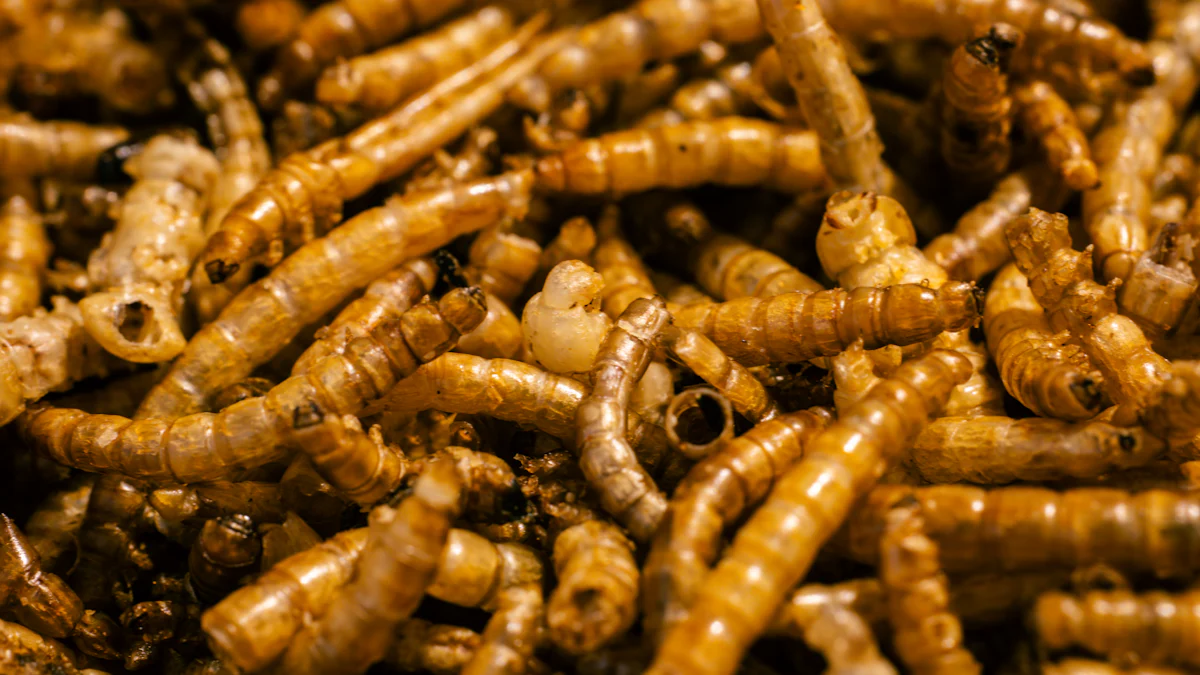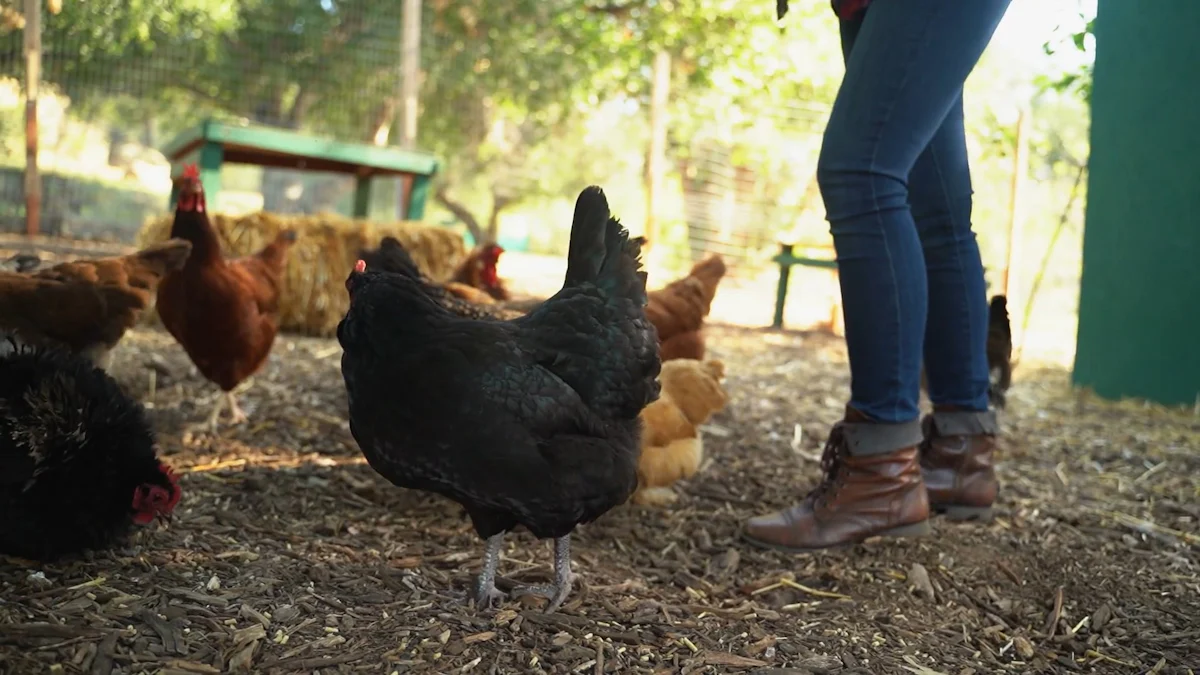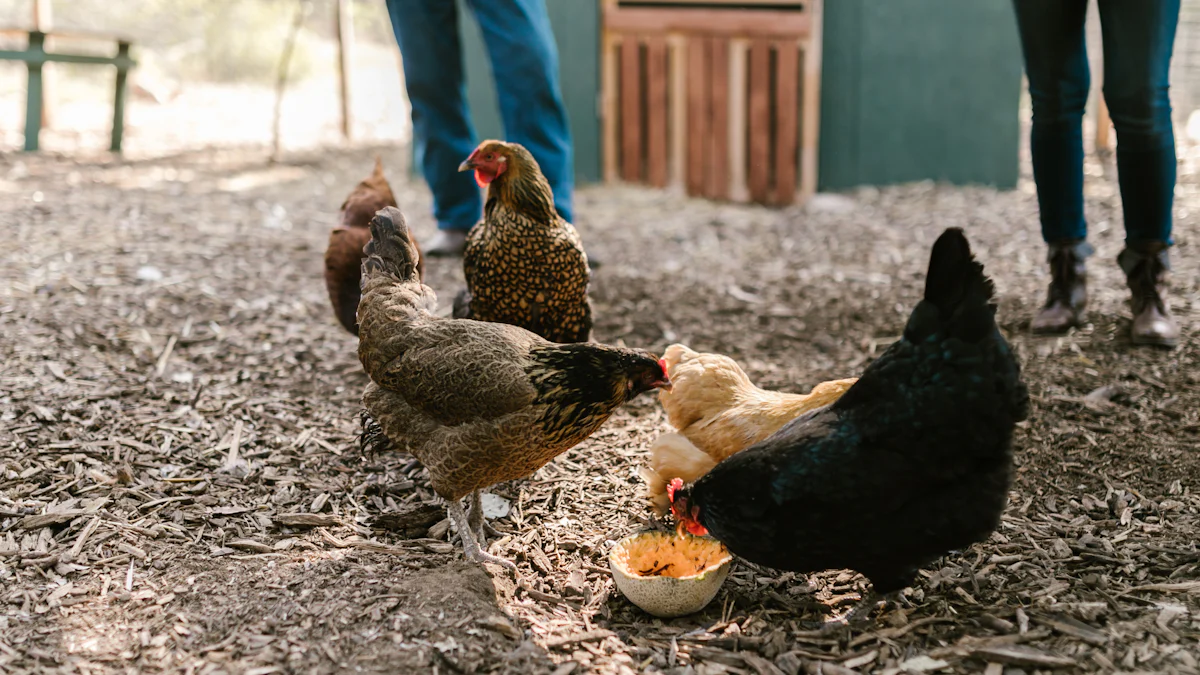
Dried mealworms for chickens are a powerhouse of nutrition. Packed with 50-60% protein, they support egg production, muscle growth, and feather health. Their natural fats boost energy, while vitamins and minerals enhance overall well-being. Convenient to store and feed, mealworms also encourage foraging, keeping chickens active and reducing harmful behaviors like feather pecking.
Key Takeaways
- Dried mealworms are a healthy snack for chickens. They have about 50% protein, helping with eggs and muscle growth.
- Spreading mealworms around helps chickens search for food naturally. This keeps them busy and stops boredom problems like feather pecking.
- Don’t overfeed; mealworms should be only 10% of their daily food. This avoids weight gain and keeps chickens healthy.
Why Feed Dried Mealworms for Chickens?

Nutritional Benefits of Dried Mealworms
Dried mealworms for chickens are packed with essential nutrients that promote their health and productivity. With a protein content of around 50%, mealworms provide a significant boost compared to other common feed supplements like corn or wheat.
| Feed Type | Protein Content |
|---|---|
| Mealworms | ~50% |
| Corn | Lower than mealworms |
| Wheat | Varies |
This high protein level supports muscle growth, feather development, and egg production. Additionally, dried mealworms contain healthy fats, vitamins, and minerals that strengthen the immune system, helping chickens fight off illnesses. Their exoskeletons also contain chitin, which promotes gut health by reducing harmful bacteria in the digestive system.
Practical Advantages of Dried Mealworms
Dried mealworms for chickens are not only nutritious but also incredibly convenient. Unlike live mealworms, they don’t require refrigeration and can be stored in airtight containers or resealable bags. This makes them easy to handle and store for months without losing freshness.
- Dried mealworms mimic the insects chickens naturally forage for, encouraging instinctual behaviors.
- Scattering mealworms keeps chickens active and reduces boredom, preventing harmful habits like feather pecking.
- They’re suitable for all chicken breeds and ages, from growing chicks to older hens recovering from molting.
Buying dried mealworms in bulk, such as a 5 lb bag, offers cost savings and ensures a steady supply of treats for small to medium flocks.
How Mealworms Improve Egg Production and Overall Health
Adding dried mealworms to a hen’s diet can significantly enhance egg production. The high protein content helps laying hens produce stronger eggshells and richer yolks. Chickens fed mealworms often lay more frequently, resulting in healthier and higher-quality eggs.
- Mealworms provide nutrients that hens need for efficient egg production.
- Feeding mealworms during egg-laying seasons boosts productivity and overall health.
- They’re especially beneficial for hens during molting or recovery periods.
By supporting both egg production and immune health, dried mealworms for chickens are a versatile and valuable addition to their diet.
How to Feed Dried Mealworms to Your Chickens

Mixing Mealworms with Regular Feed
Adding dried mealworms to regular chicken feed is an easy way to boost nutrition without disrupting feeding routines. To ensure a balanced diet, follow these steps:
- Pair mealworms with grains like cracked corn or oats to balance protein with carbohydrates.
- Add fresh fruits and vegetables, such as watermelon or leafy greens, for vitamins and hydration.
- Include seeds or crushed nuts to provide healthy fats and extra nutrients.
- Blend mealworms into standard feed to enhance its nutritional value.
- Rotate treats to mimic natural foraging habits and prevent dietary monotony.
This method works well for all chicken breeds and ages. It ensures chickens get the benefits of dried mealworms while maintaining a varied and complete diet.
Scattering Mealworms for Foraging
Chickens are natural foragers, and scattering dried mealworms encourages them to engage in instinctive behaviors. This activity keeps them active and entertained while promoting mental stimulation. Foraging also helps prevent boredom, which can lead to negative behaviors like feather pecking.
Mealworms are a natural, unprocessed treat that chickens love to hunt for. Tossing them around the coop or yard mimics the experience of finding insects in the wild. This not only provides healthy fats and amino acids but also encourages a more active lifestyle.
Hand-Feeding Mealworms to Build Trust
Hand-feeding dried mealworms is a great way to bond with chickens. Over time, they associate their owner with positive experiences, making them more comfortable and friendly. This method is especially helpful for taming younger chickens or new flock members.
Holding mealworms in your palm allows chickens to approach and eat directly from your hand. This builds trust and helps shy or skittish birds feel more at ease. It also gives owners a chance to observe their chickens closely, checking for any health or behavioral issues. Some owners even use mealworms as rewards to train chickens to perform tricks or navigate obstacle courses.
How Much Dried Mealworms Should Chickens Eat?
Recommended Daily Portions for Adult Chickens
Chickens love mealworms, but moderation is key. For adult chickens, 10-12 mealworms per day is a healthy amount. This provides a protein boost without overloading their diet. Treats like mealworms should make up no more than 10% of their daily food intake. For reference, this translates to about 10-25 grams of mealworms per chicken, depending on their size and energy needs.
Overfeeding can lead to problems. Mealworms are nutrient-dense, with a fat content of 25-30%, much higher than the recommended 3.5% daily fat intake for chickens. Too many mealworms can cause weight gain, which may reduce egg production and even make laying eggs more difficult. A handful of mealworms shared among a small flock is often enough to keep them happy and healthy.
Adjusting Portions for Weather and Activity Levels
Chickens’ needs change with the seasons. During molting or egg-laying periods, they benefit from extra protein. Increasing mealworm portions slightly during these times can help them recover faster and maintain energy. However, mealworms should still stay within the 10% treat limit.
In colder weather, chickens burn more calories to stay warm. A few extra mealworms can provide the energy they need. On the other hand, during warmer months or when activity levels drop, it’s best to reduce portions. Watch for signs like dull feathers or low energy, which may indicate a need for more protein.
Feeding Frequency and Moderation Tips
Feeding mealworms too often can create dependency. To avoid this, limit treats to 2-3 times a week. This keeps chickens excited about mealworms without disrupting their balanced diet.
| Feeding Frequency | Effect on Dependency |
|---|---|
| Daily | High dependency risk |
| 2-3 times a week | Moderate dependency |
| Weekly | Low dependency risk |
Rotating mealworms with other treats like fruits or grains ensures variety and prevents boredom. Pairing mealworms with regular feed also helps maintain a balanced diet. Remember, a little goes a long way when it comes to these protein-packed snacks.
What to Do If Your Chickens Don’t Eat Dried Mealworms
Rehydrating Mealworms to Enhance Appeal
Some chickens may not recognize dried mealworms as food, especially if they’re used to live insects. Rehydrating mealworms can make them more appealing by giving them a softer, more lifelike texture. This method works well in hot, dry weather and can even add extra nutrients depending on the liquid used.
To rehydrate mealworms:
- Use warm water to soften their tough outer shells quickly.
- Cover the mealworms completely and let them soak for 15-30 minutes.
- Drain the excess liquid using a fine mesh strainer or colander.
Other liquids, like apple cider vinegar or seed oils (flax or hemp), can enhance the nutritional value. Rehydrated mealworms often look shinier and more appetizing, which helps picky eaters give them a try.
Combining Mealworms with Other Treats
Pairing mealworms with other treats can encourage chickens to eat them. Mixing them with grains like cracked corn or oats provides energy, while fresh fruits and vegetables like watermelon or leafy greens add hydration and vitamins. Seeds and nuts, such as sunflower or pumpkin seeds, offer healthy fats and variety.
For picky eaters, try these combinations:
- Blend mealworms into their regular feed for consistent protein intake.
- Scatter mealworms with grains to mimic natural foraging.
- Pair mealworms with juicy fruits to make them more enticing.
This approach not only introduces mealworms but also keeps chickens’ diets balanced and interesting.
Gradual Introduction for Picky Eaters
Chickens unfamiliar with dried mealworms may need time to adjust. Start by offering a small handful as a treat. Scatter them on the ground or in the coop to mimic foraging. Mixing mealworms with their favorite foods, like grains or vegetables, can also help.
Hand-feeding mealworms is another effective method. It builds trust and allows chickens to associate mealworms with positive experiences. Rehydrating mealworms before introducing them can further increase their appeal. With patience and consistency, even the pickiest chickens can learn to enjoy this nutritious treat.
Feeding dried mealworms to chickens offers numerous benefits. Their high protein content supports egg production and muscle growth, while essential fats and vitamins boost energy and overall health. Mealworms also encourage natural foraging, keeping chickens active and mentally stimulated.
Experimenting with feeding methods, like mixing mealworms with grains or scattering them for foraging, can make mealtime fun and rewarding. These treats are easy to store and simple to use, making them a practical addition to any flock’s diet. With proper moderation, mealworms provide a nutritious and effective way to enhance your chickens’ well-being.
FAQ
How often should chickens eat dried mealworms?
Chickens should eat mealworms no more than twice a week. Rotate treats to maintain variety. Limit mealworms to 10% of their daily food intake for balanced nutrition.
Can baby chicks eat dried mealworms?
Yes, but in moderation. Crush mealworms into smaller pieces for easier digestion. Offer them as occasional treats alongside chick starter feed to ensure proper growth and development.
What’s the best way to store dried mealworms?
Store dried mealworms in airtight containers. Keep them in a cool, dry place to maintain freshness. Avoid exposure to moisture or direct sunlight to prevent spoilage.


